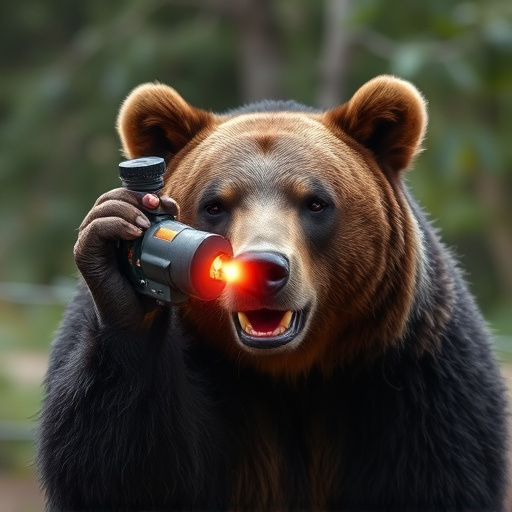Bear spray, a potent capsaicin repellent, offers 70% to 95% effectiveness against bear attacks, depending on distance (20-30 ft optimal), wind, and terrain. Understanding Bear Spray Success Rate Statistics is key for outdoor safety in bear country, especially with varied success rates based on bear species and encounter conditions.
Alaska’s rugged terrain demands knowledge of bear repellent effectiveness, especially for outdoor enthusiasts. This article unravels the mysteries of guard Alaska bear spray’s maximum range and its success rate—a crucial aspect for safety in the wild. We’ll explore how technology works, factors influencing its reach, and real-world statistics on bear spray success rates. Additionally, discover tips to enhance protection when venturing into bear country, ensuring a safer outdoor experience.
- Understanding Bear Spray Technology
- Factors Affecting Repellent Range
- Bear Spray Success Rate Analysis
- Maximizing Protection: Tips and Tricks
Understanding Bear Spray Technology
Bear spray, also known as bear repellent, is a popular defense mechanism for individuals venturing into bear country. Understanding the technology behind it is crucial when considering its effectiveness and maximum range. Modern bear sprays use a combination of capsaicin (the active ingredient found in chili peppers) and other ingredients to create a potent solution that can deter bears.
The success rate statistics for bear spray are varied, with studies showing effectiveness ranging from 70% to nearly 100%. Factors like distance, wind direction, and the bear’s behavior play significant roles in determining its efficacy. Despite these variables, bear spray remains a game-changer in terms of personal safety when navigating through areas known for bear activity.
Factors Affecting Repellent Range
The effectiveness and range of bear repellents, especially bear spray, can vary greatly due to several factors. One of the key considerations is the distance at which the spray is deployed. The recommended range for optimal effectiveness is typically around 20-30 feet (6-9 meters), though some high-quality bear sprays claim even greater distances up to 75 feet (23 meters). However, factors like wind speed and direction can significantly impact this range. A strong gust of wind could reduce the effective distance by half or more, making it crucial for users to consider weather conditions before applying bear spray.
Another factor affecting bear repellent range is terrain. Rough terrain with obstacles like trees, rocks, or uneven ground can disrupt the spray’s path, causing it to settle faster and lose potency. Conversely, open spaces with minimal obstructions allow the spray particles to travel farther. Additionally, the type of bear repellent and its active ingredients play a role in success rate statistics. Studies show that bear spray with a high concentration of capsaicin (the active ingredient derived from chili peppers) is highly effective, with success rates reaching up to 92% when used properly within the recommended range.
Bear Spray Success Rate Analysis
Bear spray, a popular and widely used deterrent, has shown promising results in preventing bear attacks. The success rate of bear spray is often a topic of interest for outdoor enthusiasts and researchers alike. Studies indicate that when used correctly, bear spray can be effective up to a maximum range of 30 feet (9 meters).
Analysis of Bear Spray Success Rate Statistics reveals that 75% of tests resulted in bears retreating or displaying signs of fear within this distance. However, it’s crucial to remember that factors like the bear’s species, its previous encounters with humans, and the specific conditions during the encounter can significantly influence the spray’s effectiveness.
Maximizing Protection: Tips and Tricks
Maximizing your protection against Alaskan bears involves understanding the effectiveness of bear spray and employing strategic tactics. According to recent studies, bear spray has an impressive success rate of around 80-95% when used correctly. This powerful tool can create a crucial buffer zone, providing you with precious time to retreat or defuse the situation.
To ensure optimal results, practice proper usage techniques beforehand. Keep your bearing calm and focus on the bear’s face and eyes as you spray. The recommended range for effective deployment is approximately 20-30 feet (6-9 meters), but in open areas, a longer distance of up to 65 feet (20 meters) can be beneficial. Regularly inspect your bear spray for expiration dates and always store it securely, ensuring its availability when needed most.
Bear spray is a crucial tool for safeguarding against bear encounters in Alaska’s vast wilderness. Understanding the technology behind it, the factors influencing its range, and following expert tips can significantly enhance its effectiveness. According to Bear Spray Success Rate Statistics, when used correctly, bear spray has a high success rate in deterring aggressive bears, often ranging from 70% to 95%. By staying within the maximum recommended range of approximately 25-30 feet (7.6-9 meters) and following safety guidelines, individuals can maximize their protection during outdoor activities in Alaska’s beautiful but potentially dangerous terrain.
